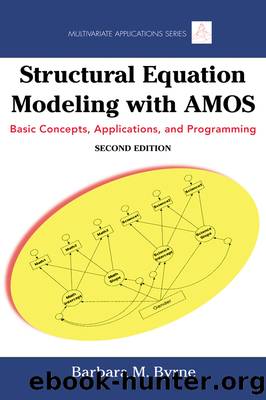Structural Equation Modeling With AMOS by Byrne Barbara M

Author:Byrne, Barbara M.
Language: eng
Format: epub
Publisher: Taylor and Francis
Figure 7.1 Initially hypothesized model of 20-item MBI structure for elementary and secondary teachers.
Establishing baseline models: The general notion
Because the estimation of baseline models involves no between-group constraints, the data can be analyzed separately for each group. However, in testing for invariance, equality constraints are imposed on particular parameters and, thus, the data for all groups must be analyzed simultaneously to obtain efficient estimates (Bentler, 2005; Jöreskog & Sörbom, 1996a); the pattern of fixed and free parameters nonetheless remains consistent with the baseline model specification for each group.4 However, it is important to note that because measuring instruments are often group specific in the way they operate, it is possible that these baseline models may not be completely identical across groups (see Bentler, 2005; Byrne, Shavelson, & Muthén, 1989). For example, it may be that the best-fitting model for one group includes an error covariance (see, e.g., Bentler, 2005) or a cross-loading (see, e.g., Byrne, 1988b, 2004; Reise, Widaman, & Pugh, 1993), whereas these parameters may not be specified for the other group. Presented with such findings, Byrne et al. (1989) showed that by implementing a condition of partial measurement invariance, multigroup analyses can still continue. As such, some but not all measurement parameters are constrained equal across groups in the testing for structural equivalence or latent factor mean differences. It is important to note, however, that over the intervening years, the concept of partial measurement equivalence has sparked a modest debate in the technical literature (see Millsap & Kwok, 2004; Widaman & Reise, 1997). Nonetheless, its application remains a popular strategy in testing for multigroup equivalence and is especially so in the area of cross-cultural research. The perspective taken in this book is consistent with our original postulation that a priori knowledge of major model specification differences is critical to the application of invariance-testing procedures.
Download
This site does not store any files on its server. We only index and link to content provided by other sites. Please contact the content providers to delete copyright contents if any and email us, we'll remove relevant links or contents immediately.
| Biomathematics | Differential Equations |
| Game Theory | Graph Theory |
| Linear Programming | Probability & Statistics |
| Statistics | Stochastic Modeling |
| Vector Analysis |
Weapons of Math Destruction by Cathy O'Neil(5031)
Factfulness: Ten Reasons We're Wrong About the World – and Why Things Are Better Than You Think by Hans Rosling(4016)
Factfulness_Ten Reasons We're Wrong About the World_and Why Things Are Better Than You Think by Hans Rosling(2751)
Descartes' Error by Antonio Damasio(2728)
A Mind For Numbers: How to Excel at Math and Science (Even If You Flunked Algebra) by Barbara Oakley(2688)
TCP IP by Todd Lammle(2633)
Applied Predictive Modeling by Max Kuhn & Kjell Johnson(2474)
Fooled by Randomness: The Hidden Role of Chance in Life and in the Markets by Nassim Nicholas Taleb(2408)
The Book of Numbers by Peter Bentley(2400)
The Tyranny of Metrics by Jerry Z. Muller(2399)
The Great Unknown by Marcus du Sautoy(2180)
Once Upon an Algorithm by Martin Erwig(2142)
Easy Algebra Step-by-Step by Sandra Luna McCune(2111)
Practical Guide To Principal Component Methods in R (Multivariate Analysis Book 2) by Alboukadel Kassambara(2088)
Lady Luck by Kristen Ashley(2067)
Police Exams Prep 2018-2019 by Kaplan Test Prep(2028)
Linear Time-Invariant Systems, Behaviors and Modules by Ulrich Oberst & Martin Scheicher & Ingrid Scheicher(1980)
All Things Reconsidered by Bill Thompson III(1957)
Secrets of Creation, Volume 1: The Mystery of the Prime Numbers by Watkins Matthew(1858)
